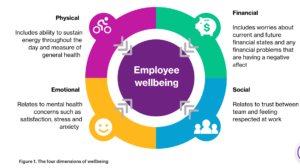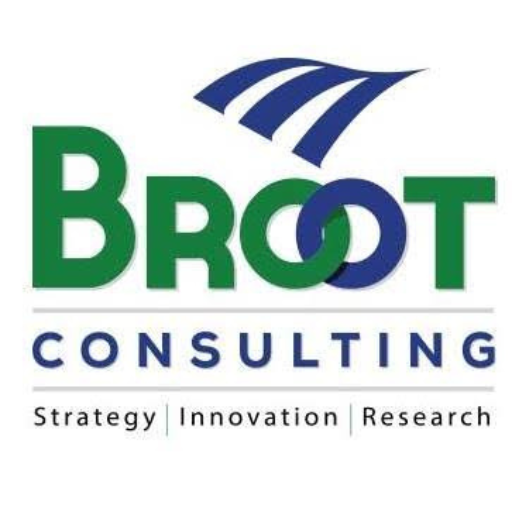A significant percentage of employees’ daytime is spent in the workplace. The workplace can, therefore, promote employee mental well-being or become a source of mental health problems. Of about 60% of the world’s population are currently in work, 15% of working-age adults or one out of eight have mental health challenges. Among the mental health issues, depression and anxiety cost the global economy US$ 1 trillion annually. The impact of the heightened mental health challenges has reduced productivity. Factors contributing to mental health challenges in the workplace have been identified to include excessive workload, long working hours, lack of control over job design or workload, poor working conditions, financial pressures, violence, harassment and discriminatory practices, unfair and inequitable reward systems, poor task definition and bad organizational culture.

The above are the dimensions of well-being. Of the four dimensions, emotional well-being is critical to the others. An emotional wreck cannot be stable enough to pay attention to physical, social and financial well-being. This is why paying attention to mental health is critical in the workplace. Professionals spend a huge amount of time at work and most people define success by how well work is going or how well they are doing professionally. Can we dispute this? Maybe not. When employees are distressed at work, largely their entire well-being is disturbed because societal recognition and other factors that boost human ego are mostly associated with the work that humans do. When a man or woman drives out in an exquisite car, they are honoured or respected. When people live in their dream houses, they feel fulfilled. When they can afford the vacations and trips around the world, while also making donations to different foundations, humans find fulfilment. On this basis, people hold their source or sources of income dear as life itself. It is on this grounds that it is important to pay attention to wellness in the workplace.
It has become cliché and a true one that happy employees make a great Organisation. Ensuring employee wellness should be at the center of organizational strategy because strategy will not implement itself. We need humans to execute strategy. Otherwise, a strategy document will remain on the shelf and tables. Disgruntled employees cannot be extra-milers. Most organizations carry deadwoods as staff. Deadwoods are category of staff that have already disengaged from the organization. They are just earning paychecks till they find a better job elsewhere. For the deadwoods, there is no remedy for their situation until they leave because they have lost absolute trust in the organization. Another category of employees are the semi-engaged ones. They are semi-engaged because they feel not well-treated on the job and a change in the situation will lead to active engagement on their part. The third category of employees are those that are self-motivated. Regardless of the culture of the organization, employees with a strong self-drive cannot be deterred by any rude organizational culture. Instead, they will resign immediately. It is either they are in and giving their best or they are out. These are the high flyers.
It is critical for organizations to pay more attention to empathy. Empathy should be a standard value in an organization that wants to thrive with people. Organizations that put people first will promote values that are kind to human nature. Such values include: respect, clear communication, commitment to growth, openness, trust, honesty and togetherness. These values will yield teamwork, collaboration, clarity, trust, growth and winning together. What else can a professional ask for? At the center of all these universal values is empathy. When empathy is promoted in an organization, everyone will carry the consciousness of the need to lead from the heart. Leading starts with the self and then other co-workers. When everyone is conscious of leading from the heart, storytelling becomes the norm. Again, at the heart of storytelling is empathy. When decisions are made from storytelling, it is more effectual. Also, when tasks are given via storytelling, there is more clarity. When organizations start goal setting from storytelling, which can sometimes link history to the present, decisions are well thought out and the people can better connect to the goals. Goals are better achieved when there is clarity and importantly, when the people can connect with the goals.
How can organizations better drive a culture of trust? Trust is simply when individuals don’t have to second-guess if they are safe or not. In the context of an organization, trust is when employees do not have to worry if their decision to stay with an organization is not mistaken. Suffice to say that trust breeds loyalty. Again, to the question: how do we build a culture of trust in an organization? It is the mindset that we need to work on. When the mindset is centered on growth, in this case both for the individual and the organization, people will work with the consciousness that growth should happen, not just for the organization but for the individuals too. Not just for one individual but for all. It is this selflessness that will promote flexibility and togetherness. At the center of it all is still empathy. There has to be a mindset shift to collective growth. Appraisal systems and the ensuing reward systems should be to promote growth. If the core reason behind appraisals, learning and development, rewards, and employee engagement is growth, both for the organization and all the people, it is this growth mindset that will drive people to align with a culture that truly promotes growth. The next question is how do we measure growth?
The measurement of growth is in the satisfaction levels of the people. This is why taking survey is important in an organization. However, to get reliable survey results, there should be trust in an organization. Also, the turnover rate and the growth rate in terms of revenue and meeting set objectives, are other ways of measuring satisfaction levels in an organization. More so, the employment brand of the organization also speaks to satisfaction levels amidst existing employees. Most professionals, before joining an organization, consider the wellness of the existing staff of the organization. As mentioned, wellness can be viewed from different dimensions: physical, social, mental and financial. When culture is well-defined and considered during hiring decisions, the problem of a culture-fit will not crop up. An organization that has strong employer branding is more likely to attract top talent. Ideally, in such an organization, every member complements each other, fostering a collaborative environment. Therefore, in an organization committed to growth and development, the concept of underperformers should not exist, as everyone is geared towards continuous improvement and collective success. Again, the mindset matters.
Employees who are content and well-cared for tend to be more productive and positive. The idea of a ‘great place to work’ isn’t just a theoretical framework; it’s about creating a genuinely exceptional workplace. Activities that foster engagement and satisfaction among employees should encompass aspects like lifestyle management, physical wellness, employee support, engagement, and emotional well-being. Employers are encouraged to be innovative in these activities, though some popular and effective ones include:
Physical Health: This may involve initiatives such as fitness challenges, nutritional education, health screenings, and programs to quit smoking or manage weight. Unity Bank Nigeria Plc, recently introduced an interesting policy to nudge people towards physical health. The organization turned off the elevator from Level 1 to Level 2 to compel people to use the stairs. The interesting part of the policy is that the restaurant is not on the ground floor but on the first floor. Organizations can also intentionally create team bonding activities around promoting physical health.
Mental and Emotional Well-being: Programs often include stress management workshops, mental health resources, counselling services, and activities that promote work-life balance. Some organizations discourage sending out official emails at after the official closing hour. Organizations that are particular about wellbeing are flexible in relating with talents and we now have more cases of remote working or the option of working remotely.
Preventive Healthcare: Encouraging regular check-ups, vaccinations, and early intervention in health-related issues.
Lifestyle Management: Promoting healthy habits, including proper diet, exercise, and sleep, as well as managing chronic diseases. Ensuring only healthy foods are served in the office cafeteria and also sensitizing employees towards healthy habits such as drinking water, washing hands, exercising, etc.
Employee Engagement and Support: Activities and resources that foster a supportive community among employees, enhancing motivation and teamwork. The reward system in organizations should promote team collaboration above individual efforts. However, the performance management system should have a way of measuring individual contributions to team success. Organizations should practice healthy house-keeping. That is showing concerns for how employees feel or how decisions can affect employees. The reward policy should carry many benefits-in-kind to employees such that employees are at peace that they are covered even if certain needs arise. For example, availability of loans (personal or vehicle) with zero interest or a very low interest rate; mortgage facilities, etc.
Educational Components: Seminars, webinars, and workshops on various wellness topics to empower employees with knowledge and skills for maintaining their health. More so, conducting training needs analysis is crucial for organizations to offer tailored training opportunities to employees.
Organizations that invest in corporate wellness experts see enhanced value. Similarly, allocating a budget for employee wellness is as crucial as funding product advertising. Just as a quality product fails to reach its potential without effective marketing, an organization cannot fully leverage its workforce’s capabilities if it neglects employee wellness. Central to this is the establishment of a strong corporate culture that prioritizes the holistic well-being of its staff.






